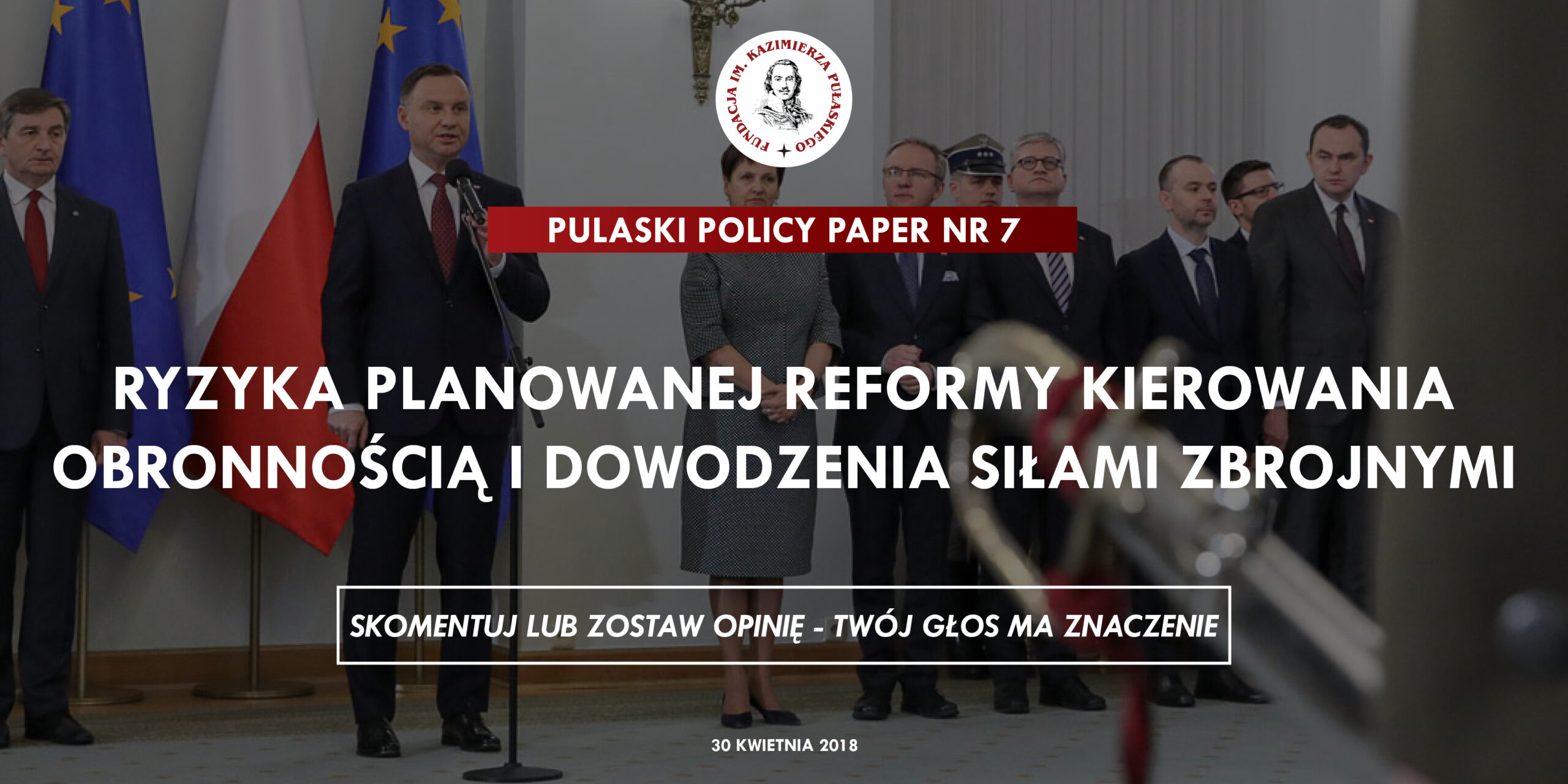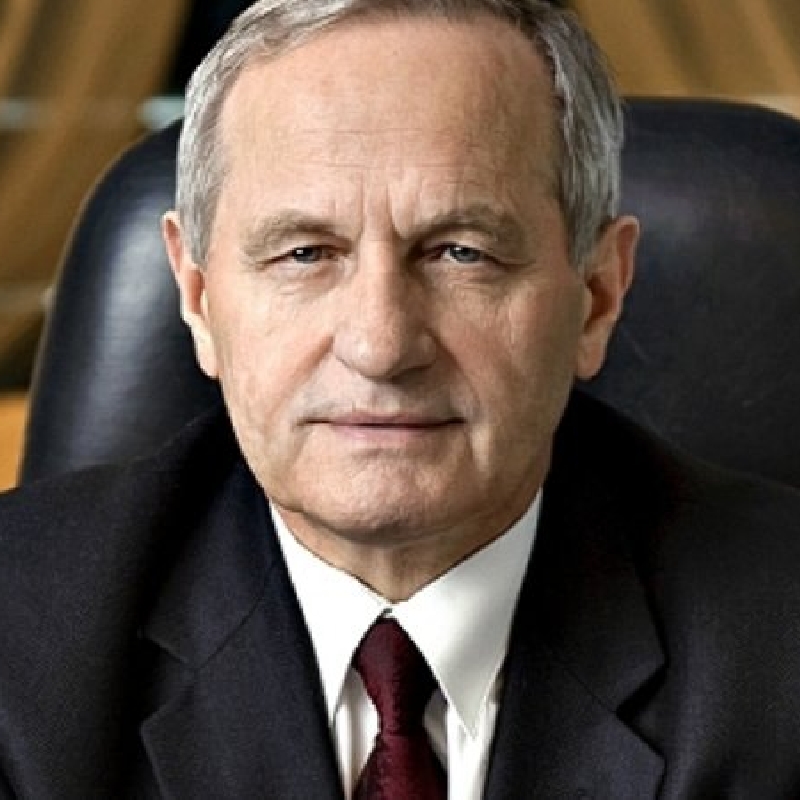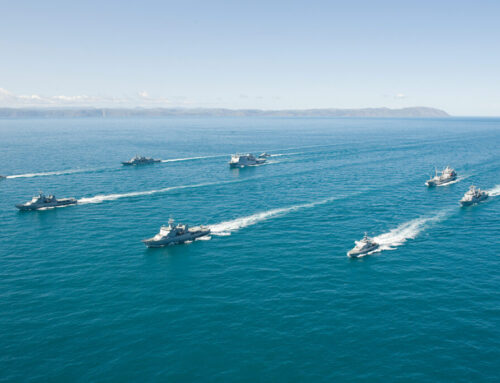Reforma_dowodzenia_sił_zbrojnych
Autor foto: Domena publiczna

The risks of the proposed reform of the command and control system of Poland’s Armed Forces
April 30, 2018
Author: Stanisław Koziej




Reforma_dowodzenia_sił_zbrojnych
Autor foto: Domena publiczna
The risks of the proposed reform of the command and control system of Poland’s Armed Forces
Author: Stanisław Koziej
Published: April 30, 2018
Pulaski Policy Paper No 7, April 30, 2018 r.
The Ministry of National Defence and the National Security Bureau have announced that the consultations on the reform of the command and control system of the Polish Armed Forces will end soon. Contrary to the previous reform, this issue has not been raised in the public debate so far despite that both experts and politicians should be involved in the discussion over the final shape of the document. Therefore, it is necessary to sum up the most important elements of the reform and point out those deemed to be the most controversial and questionable.
The interdependence of the civilian control and military command systems
The government and the President attempt to change the system established by two amendment acts in 2013 and 2015 which have introduced two subsystems: a) the civilian national security management in times of peace and war; and b) the military command system of the Polish Armed Forces. However, the proposal of the Ministry of National Defence as well as the counterproposal of the National Security Bureau were limited to the issue of the command hierarchy in the military. The entire problem has been thus reduced to the military perspective, disregarding all possible consequences for the political and strategic decision-making process. There is a fatal flaw in this line of reasoning which entails considerable risks.
Despite the fact that there is a fundamental distinction between the civilian national security management and the command and control system of the Armed Forces, these two issues are actually inseparable. It seems impossible to settle matters relating to the strategic level of the military command without taking into consideration the consequences for the civilian control of the military and the political leadership. Given that the civilian administration is at the top of the chain of command, the civilian control over the military should have been the first thing to reform. The Chief of the General Staff of the Polish Armed Forces is the most important link between the political leadership and the command and control system; therefore, his position and competencies within this structure are absolutely essential.
Strategic assistance for the civilian leadership
According to Poland’s security and defence system, the Armed Forces are under civilian control of the government (the Council of Ministers and the Ministry of National Defence) which cooperates with the President. In time of war, however, the President is supposed to command the military in cooperation with the Council of Ministers as a consequence of Poland’s dual executive system. The reform proposal has not envisaged any modification of the chain of command despite the opinions that the government should be responsible for defence and thus have authority over the Commander-in-chief whose appointment in time of war is stipulated in the Constitution. However, the future organisational structure of the defence subsystem remains in question, regardless of the final shape of the chain of command in time of war.
Currently, this subsystem consists of policy makers (the Minister of National Defence, the Council of Ministers and the President) and an advisory body (the Chief of the General Staff and the General Staff itself). The latter one is responsible for supporting the Minister of National Defence in time of peace as well as advising the President in time of war. Thus the Chief of the General Staff maintains strategic continuity of the system in times of peace and war.
The proposed reform will have a devastating impact on the military sphere of the defence subsystem despite its disregard to the civilian level. By appointing the Chief of the General Staff as the Command-in-chief of the Armed Forces, the reform will leave the civilian and political leadership of the state shorn of its advisory body. Consequently, the government will have no strategic backup to carry out its tasks. Given the powers of the US president, Secretary of Defence and the US Congress, it is worth noting the continued expansion of civilian control of the military in modern democracies.
The role of civilian control of the Polish Armed Forces has significantly evolved since the 1990s when the political authority over the military was rather limited. Today, the government plays a strategic role in a decision-making process in terms of military modernisation, organisational structure of the Armed Forces, weaponry, equipment, operational matters in time of war and even in terms of tactics in the case of international missions and operations.
Without a professional support of the military at the strategic level, the civilian administration would be ‘constrained’ to make decisions based on their own assessment and perception. In recent times, the Ministry of the National Defence has been representing such an arbitrary approach to the command and control of the military by ignoring an obligation to consult with the Chief of the General Staff, for example regarding the Territorial Defence Force. The proposed reform of the command and control system of the Armed Forces can turn the aforementioned distortions into a legitimate model of the civilian control of the military.
Therefore, the appointment of the Chief of the General Staff as the Commander-in-chief of the Polish Armed Forces and his transfer from the ‘state’ civilian level to the military command structure means that the civilian administration will lose an advisory body at the strategic level. Moreover, this decision will also rule out a legal obligation to involve military advisors in a decision-making process. Undoubtedly, this is a fatal flaw of the proposed reform which will lead to deterioration in the political and strategic dimension of the command and control system in time of war. Furthermore, it will increase the risk of arbitrary approach to the civilian and democratic control of the Polish Armed Forces.
Chief of the General Staff as a keystone of the political-strategic security management and the military command system
Currently, the Chief of the General Staff is not a direct commander of the Armed Forces but a right-hand man of the government in terms of political and strategic decision-making process. The Chief of the General Staff is involved in formulating strategic tasks for the military and supports supervision of their implementation by the military command system. Chief of the General Staff is a keystone of the command and control system of the Armed Forces. According to the proposed reform, the Chief of the General Staff is appointed as a commander-in-chief of the Armed Forces who is responsible for preparation and implementation of the tasks given to the military even in time of peace. This is a serious mistake given that the civilian administration will lose professional military advisor. There are also other risks relating to the military command system at the strategic level.
A scenario in which the Chief of the General Staff plays a role of a strategic commander is a return to the military command model of the early 1990s which was implemented by Gen. T Wilecki and F. Puchała. Consequently, a commander holding the highest military rank and the most important military position in the country will become an autonomous strategic body responsible for planning military tasks for himself, implementing these tasks, evaluating their implementation, reporting results and conclusions to the civilian administration, and submitting proposals. The existence of such an omnipotent military body in a democratic system may be risky for the state and the institution itself. The threats of the proposed reform can be illustrated with the infamous ‘Drawsko Dinner’ in the early 1990s, despite entirely different circumstances and the constitutional situation at that time. During the ‘Drawsko Dinner’, the Minister of National Defence was spectacularly dismissed by then Chief of the General Staff who also served as a head of the Armed Forces. Today, such a scenario is very unlikely given that the legal situation in Poland and generals’ mentality have significantly changed since the 1990s. The legal and organisational system, however, should not favour a state of affairs in which the most important military commander is pushed by some political powers in such a direction or has a specific character structure.
This scenario would be also unhealthy for the military command structure. Lack of authority and supervision could undermine a pro-active stance, lead to uncritical approach to self-evaluation, complacency, self-appeasement, lack of vigilance and voluntarism in a decision-making process. These phenomena can be extremely dangerous in a military context. Throughout history, Chief of the General Staff has not been a commander but an adviser to the highest military authority. There were exceptions to that rule, e.g. Prussia’s Helmuth von Moltke the Elder in the second half of the 19th century or gen. T. Wilecki in the 1990s after the implementation of the civilian control of the army in Poland. Today, however, there is no need to replicate the same exception given that the democratic system rules out such a scenario. The function of the Chief of the General Staff and the commander-in-chief should remain split: the commander-in-chief commands the entire armed forces, whereas the Chief of the General Staff is responsible for supervision of the command on behalf of the state authority (Ministry of National Defence, President).
It is worth noting that such a model has been implemented in the United States, which represents the most politically and militarily experienced democratic system of control over the military around the world. Chairman of the Joint Chiefs of Staff, who is an officer with the highest military rank, is not a commander but a strategic adviser to civilian leaders, President and Secretary of Defence.
The role and function of the commander-in-chief of the Armed Forces in time of war
The third important issue as far as the control and command system is concerned is the role of the commander-in-chief in time of war. According to the existing regulations, the entire Armed Forces remain under control of the government (Minister of National Defence) in times of war and peace. Commander-in-chief of the Armed Forces, however, is under President’s supervision and commands only those units that were chosen to carry out defensive operations in accordance with the plans previously approved by the President. Chief of the General Staff remains an advisory body supporting the Ministry of National Defence and the President as far as state defence in concerned. Moreover, the regulations suggest that the Operational Commander of the Armed Forces is the best candidate for the position of the commander-in-chief of the Armed Forces given that he is the one who coordinates operational training of the military staffs. Consequently, the Operational Command ought to turn into the staff of commander-in-chief once he is appointed.
Based on the proposed reform, the Chief of the General Staff will be appointed as the command-in-chief of the Polish Armed Forces and the commander of the entire Armed Forces in time of peace. There are two disadvantages of this approach. First, the reform will deprive the President of a strategic advisory body in terms of the national defence. The President will remain the only person responsible for supervising the commander-in-chief; approving his proposals and conclusions; and finally evaluating his actions. Second, the reform will eventually move the entire civilian authority over the military from the Ministry of National Defence to the President, thus establishing a ‘presidential department’. Changing the current system in this way would be unconstitutional and consequently unacceptable.
In 2017, the Chief of the General Staff Gen. L. Surawski was appointed by the President as a candidate for the position of commander-in-chief. This nomination, however, could be taken into consideration under two conditions. First, the nomination should be understood as a personal decision related to a specific general but not the Chief of the General Staff. It means that once Gen. Surawski has taken the office of the commander-in-chief, the President will be supposed to appoint new Chief of the General Staff whose primary task is to support the President and the government in defence of the state. Given the provisions of the Constitution of the Republic of Poland, the nomination of the Commander-in-chief can be approved only in time of war. Thus, the proposed reform will only duplicate this constitutional weakness by introducing the necessity of appointing new Chief of the General Staff at the same time. Second, it seems necessary to change the current role and the function of the commander-in-chief to reflect the current position of the Chief of the General Staff as an adviser to the President, the government and the Ministry of National Defence. The role of the person holding combined powers of the commander-in-chief and the Chief of the General Staff should be shifted from direct operational command of the Armed Forces (according to the current legislation) to strategic supervision of the Operational Commander (who is responsible for commanding military operations) on behalf of the President. Given the abovementioned issues it is worth considering the proposal of the National Security Bureau which suggested to establish a ‘combined command’. Such structures would be responsible for direct command of the entire Armed Forces in times of war and peace.
The importance of integrity and continuity of the command and control system
Given Poland’s existing security alignments and the location on the Alliance’s Eastern flank, there are certain operational conditions that should be taken into account in the context of the national security management and the command and control system of the military. Both systems need to be capable of conducting multidimensional joint operations integrated with non-combat operations. The next important part of this problem is to maintain structural continuity of the entire system in times of peace, crisis, and war. Poland’s security system should be able to face various types of armed conflicts, such as hybrid warfare, a limited war or full-scale conflicts as far as allied and stand-alone military operations are concerned.
It is worth mentioning another important intention of the proposed reform, that is the re-establishment of separate military command departments of the Armed Forces (Land Forces, Air Force, Navy, Special Forces and Territorial Defence Force).
This concept does not seem to be the optimal direction given the opposite global tendency to conduct joint operations of all branches of the armed forces. In the United States, for example, policy makers take into consideration even a higher level of joint warfare, that is multidimensional and integrated civilian-military operations. Despite that the dissolution of the joint command would be acceptable, such a policy would have an adverse effect upon the military.
Modifying or re-organising the command and control system in time of war would be unacceptable as far as the rule of continuity is concerned. Therefore, it is necessary to ensure that both the political control of the military and the command and control play exactly the same role and have the same competences in times of war and peace. The system, however, should be ready for strengthening its operational structures when it is necessary. The current system can guarantee that these objectives will be achieved.
The government and the Minister of National Defence play a key role in the management of national security in times of war and peace. The President as the [civilian] Supreme Commander exercises command over the Armed Forces in times of peace and war, taking over the one-man leadership of state defence in cooperation with the Council of Ministers in time of war. The General Staff is a strategic advisory body to the Ministry of National Defence, Council of Ministers and the President and plays exactly the same role in times of peace and war. In time of peace, the Operational Command of the Armed Forces is responsible for training commands and staffs based on existing operation plans. In times of crisis, the Operational Command successively takes control of the military units designated by the Minister of National Defence for defensive purposes, and thus becomes a command unit of the commander-in-chief immediately upon his appointment. The Armed Forces General Command is responsible for the process of preparation of forces as well as their assignment for conducting crisis management operations and combat operations in time of war.
In conclusion, the dissolution of the joint command and re-establishment of a separated command for each branch of the Armed Forces would revoke the modernisation process of Poland’s command and control system. However, the removal of the Chief of the General Staff as the main advisory body to the government seems completely unacceptable. First, the reform will undermine strategic capabilities of the civilian and democratic control of the military and may lead to arbitrary power of the civilian administration over the military decision-making process. Second, there is also a risk of increased military autonomy over the political and civilian control of the armed forces.
Conclusions
- Command and control should be considered as part of a larger system and must not be seen in isolation from the political and civilian authority.
- The political authority over the military requires professional and strategic support to ensure that the entire system will remain unbiased.
- Chief of the General Staff cannot not play a double role as a commander-in-chief and his own superior.
- Commander-in-chief should not become a head of the ‘presidential defence department’ and thus eliminate the Minister of National Defence from the security management system in time of war.
- Given the current security environment and hybrid threats, the ability to conduct joint multidimensional operations, integrated with non-combat and civilian missions is of great importance. It is also crucial to maintain continuity of the command and control of the Armed Forces that ought to be able to face various types of armed conflicts, such as hybrid warfare, a limited war or full-scale conflicts as far as allied and stand-alone military operations are concerned.
- The modification of the current command and control system based on valid arguments is highly recommended, for example by increasing the role of the Armed Forces Inspectorates. However, the proposed reform should not demolish the entire system, particularly the separation of powers between the General Staff (as an advisory body responsible for planning and supervision of the Armed Forces) and the Commands of the Armed Forces.
- Given the aforementioned conclusions, it is highly recommended to raise this issue in the public debate to provide policy makers with an understanding of how the proposed reform can affect Poland’s security and defence system.
Author: Stanisław Koziej, Senior Fellow of Peace and Stabilisation Programme at the Casimir Pulaski Foundation





